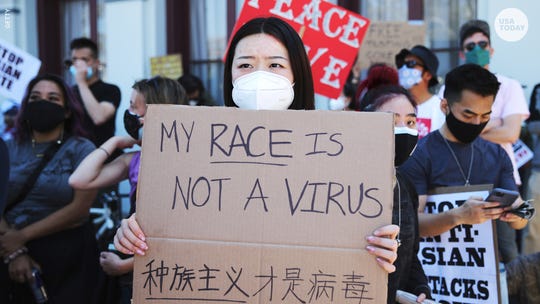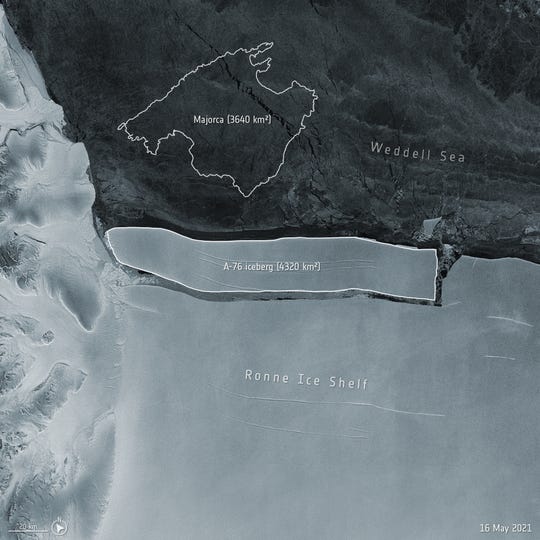
Cease-fire
Israel approved a unilateral cease-fire in Gaza. President Joe Biden signed a new law to combat violence against Asian Americans. And this year’s hurricane season predictions just dropped.
👋 Hey! It’s Laura. Nothing rhymes with Thursday. So here’s the news!
But first, hey, anybody lose a mysterious blob? 🤨 Scientists don’t really know what it is, but it washed up on a beach, because of course it washed up on a beach – only weird blobs and mermaids wash up on beaches. Check out the blob, and let the scientists know if you have any idea what it might be.
The Short List is a snappy USA TODAY news roundup. Subscribe to the newsletter here or text messages here.
Israel approves cease-fire in Gaza
Israeli Prime Minister Benjamin Netanyahu’s office on Thursday announced an Egyptian-brokered cease-fire to halt an 11-day military operation against Hamas militants in the Gaza Strip. Israel’s Cabinet agreed “to accept the Egyptian initiative for a bilateral cease-fire without any conditions, which will take effect later,” Netanyahu’s office said in a statement. It’s not clear when the truce will go into effect, though multiple reports have said it will be at 2 a.m., just over three hours after the Cabinet’s decision. U.S. Secretary of State Antony Blinken said he expected to speak with Israel’s foreign minister this afternoon. The violence wreaked far more devastation in Gaza than in Israel, with an estimated 58,000 Palestinians displaced from their homes and untold damage to the territory’s infrastructure, which was already dilapidated after a 14-year blockade.
- Conflict timeline: Here’s what’s happening with the 2021 conflict over the Gaza Strip.
Tens of Palestinian journalists and public looking at Al-Jala Tower after destroyed in the central of Gaza city. (Photo: Jotam Confino)
Hate hides in plain sight
Biden called Thursday for an end to the “ugly poison” of hate as he signed a new federal law aimed at combatting violence against Asian Americans. Signing the nation’s first new federal hate-crimes law in over a decade, the president denounced what he described as “gut-wrenching” attacks against Asian Americans that have surged since the spread of COVID-19 across the country. Hate in the U.S. hides in plain sight and too often is met with silence, Biden said. “Every time we’re silent, every time we let hate flourish, you make a lie of who we are as a nation,” he said, his voice rising.
Some key provisions of the COVID-19 Hate Crimes Act:
- Expedites the Justice Department’s review of hate crimes
- Designates an official at the Justice Department to oversee the effort
- Provides grants to states to improve reporting of hate crimes
Violence against Asian American and Pacific Islander communities has been on the rise for more than a year with the spread of COVID-19 and as some politicians, including former President Donald Trump, blamed China for the pandemic. More than 6,600 anti-Asian hate crimes have been reported in the year since the pandemic arrived in the U.S., jumping more than 164% in the first quarter of this year in 16 major cities.
- AAPI pride: Asian and Pacific Islander heritage helps lift America to what it must be.
- Vice President Kamala Harris denounces efforts to restrict Asian American, Pacific Islander voter rights.
The legislation would combat attacks on Asian Americans and Pacific Islanders, which have jumped amid the COVID-19 pandemic. (Photo: Getty)
What everyone’s talking about
- WHYYY is Angelina Jolie covered in bees? We’ve got the story behind the buzz.
- BBC reporter Martin Bashir used deceit to get explosive 1995 Princess Diana interview, investigation finds.
- ICE facilities shut down: Biden orders closure of two facilities after allegations of abuse, nonconsensual gynecological procedures, excessive force.
- Fact check: Can businesses legally ask if you’ve been vaccinated?Does HIPAA apply?
- Bye, Felicia. Microsoft is officially retiring the Internet Explorer web browser.
A dark statistic
The United States has yielded to India as the country with the highest single-day death toll. While daily U.S. infections, hospitalizations and deaths slide, India’s Health Ministry reported 4,529 deaths Wednesday as the coronavirus spreads beyond cities into the vast countryside, where health systems are weaker. The number is considered an undercount by most health experts. The U.S. held the previous record for daily deaths at 4,475 on Jan. 12, but struggles with near-record infections and an increasing death count have India reeling.
- India’s COVID-19 afflicted left ‘to fend for themselves’: Morgues overflowing, health care workers, overwhelmed families reach their breaking points.
- Deadly ‘black fungus’ in COVID-19 patients is appearing more frequently in India. What is it? Here’s what you need to know.
Borders to remain closed: The Department of Homeland Security says the U.S. borders with Canada and Mexico will remain restricted through at least June 21, with only trade and essential travel allowed until then. In conjunction with its Canadian and Mexican counterparts, the U.S.’ northern and southern borders were originally closed to leisure travelers in March 2020, at the start of the COVID-19 pandemic. The restrictions have been extended on a monthly basis ever since.
Policemen stand next to the bodies buried in shallow graves on the banks of Ganges river in Prayagraj, India, Saturday, May 15, 2021. Police are reaching out to villagers in northern India to investigate the recovery of bodies buried in shallow sand graves or washing up on the Ganges River banks, prompting speculation on social media that they were the remains of COVID-19 victims. (Photo: Rajesh Kumar Singh, AP)
Get ready to hunker down
This hurricane season could be a doozy. Overall,13 to 20 named storms are expected to form this year, which is considered an “active” Atlantic hurricane season, forecasters said Thursday. The season, which begins in less than two weeks, typically spawns seven hurricanes, peaks in August or September and runs through Nov. 30. If predictions hold true, 2021 will be a record sixth consecutive year of above-normal activity. Forecasters say that out of the predicted number of storms, six to 10 hurricanes could form. Storms become hurricanes when winds reach 74 mph. Of the predicted hurricanes, three to five could be major, packing wind speeds of 111 mph or higher. Forecasters also released their prediction for the eastern Pacific basin, where 12 to 18 named storms are expected.
👉 Last year, NOAA predicted 13 to 19 named tropical storms would spin up, of which six to 10 would be hurricanes. In all, a record 30 named storms formed, including 14 hurricanes. An average eastern Pacific hurricane season produces 15 named storms.
- A look at last year: Devastating 2020 Atlantic hurricane season shattered records — and lives.
- Photo gallery: Hurricanes and flooding through the years.
Galveston, Texas, hours before Hurricane Laura is set to make landfall on Aug. 26, 2020. (Photo: Chris Ramirez/Caller-Times)
Real quick
- As prices soar and bidding wars flare, many home sellers will ask above what they think their house is worth.
- House approves $1.9B for Capitol security after Jan. 6 riot, but Senate GOP calls for ‘pause.’
- ‘We will celebrate my brother’s life’: George Floyd’s family to hold rallies, marches for one-year anniversary of his death.
- A whopper of a deal: Iowa State’s Matt Campbell turned down 8-year, $68.5 million deal to coach Detroit Lions.
- Former Colorado school bus driver facing charges for slapping child for not properly wearing mask.
It’s melting
An enormous chunk of ice just broke off from Antarctica. The 1,667-square-mile block of ice is more than three times the size of Los Angeles, making it the world’s largest iceberg. Images of the iceberg were captured by the Copernicus Sentinel 1 mission after it calved from the Ronne Ice Shelf in the Weddell Sea, The European Space Agency reported. Iceberg calving is the breaking of ice chunks from the edge of a glacier and a natural process that will not lead to rises in sea levels because it was already a part of a floating ice shelf. Scientists say the rate at which icebergs are calving is likely the result of human influence. In February, another iceberg larger, this one larger than New York City, broke off Antarctica’s Brunt Ice Shelf.
- Melting faster than ever: Study says glaciers are disappearing because of global warming.
The world's largest iceberg calved from the Ronne Ice Shelf in Antarctica. (Photo: European Space Agency)
A break from the news
- 📺 What to stream this weekend: Netflix’s ‘Army of the Dead,’ Amazon Prime’s Pink documentary.
- 🏡 Home improvement hot mess: If you’re thinking about remodeling, you should expect delays, shortages and higher prices into 2022.
- 🛍️ What to buy in May:All the hottest deals to shop this month.
This is a compilation of stories from across the USA TODAY Network. Want this news roundup in your inbox every night? Sign up for The Short List newsletter here.
Source: Read Full Article



